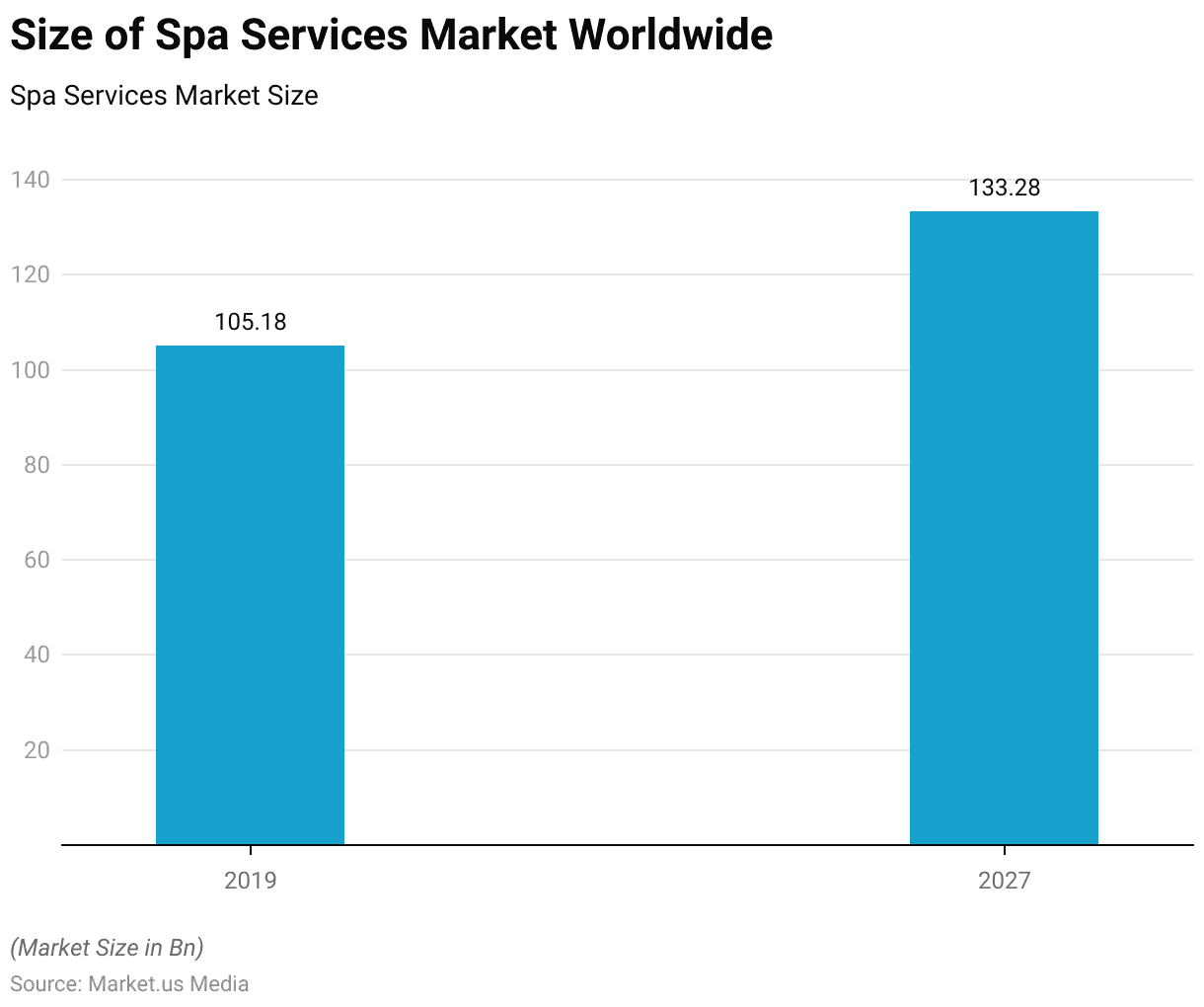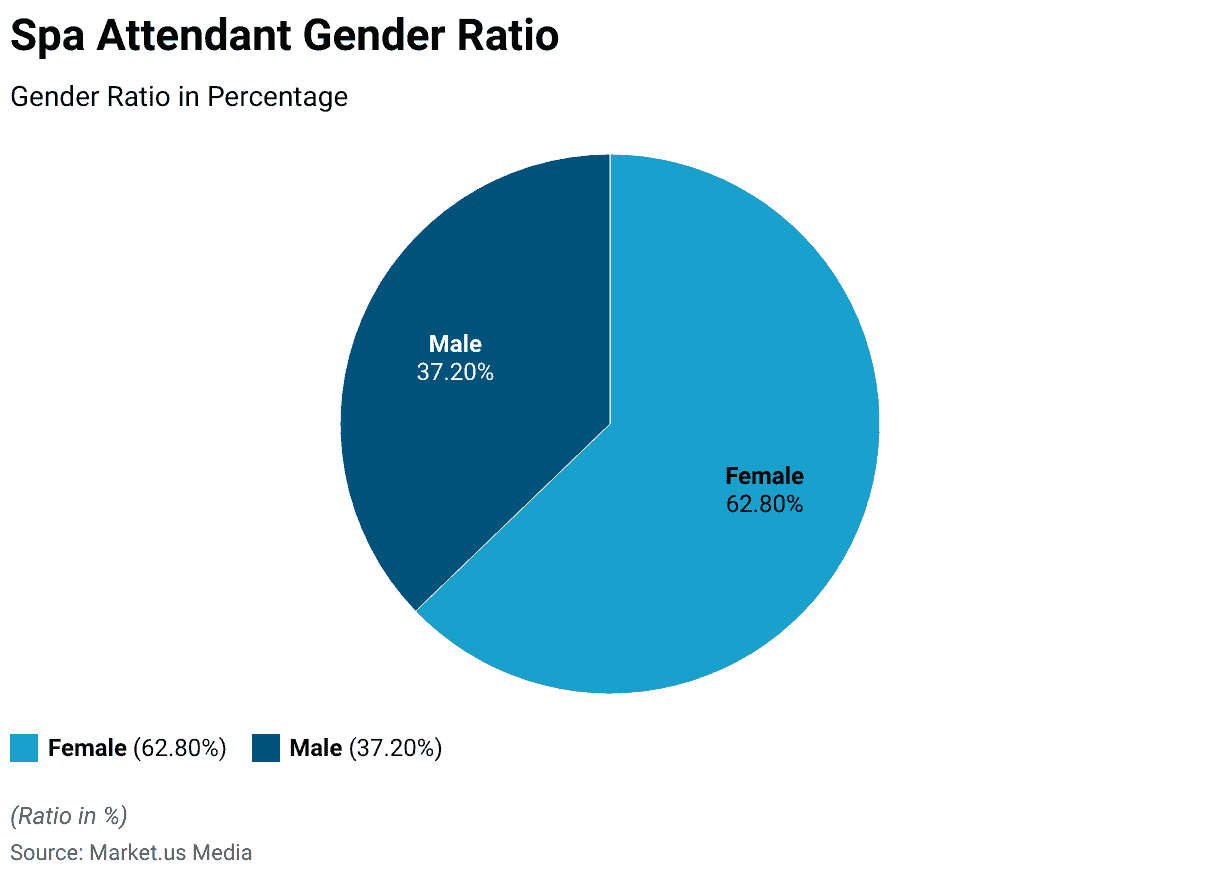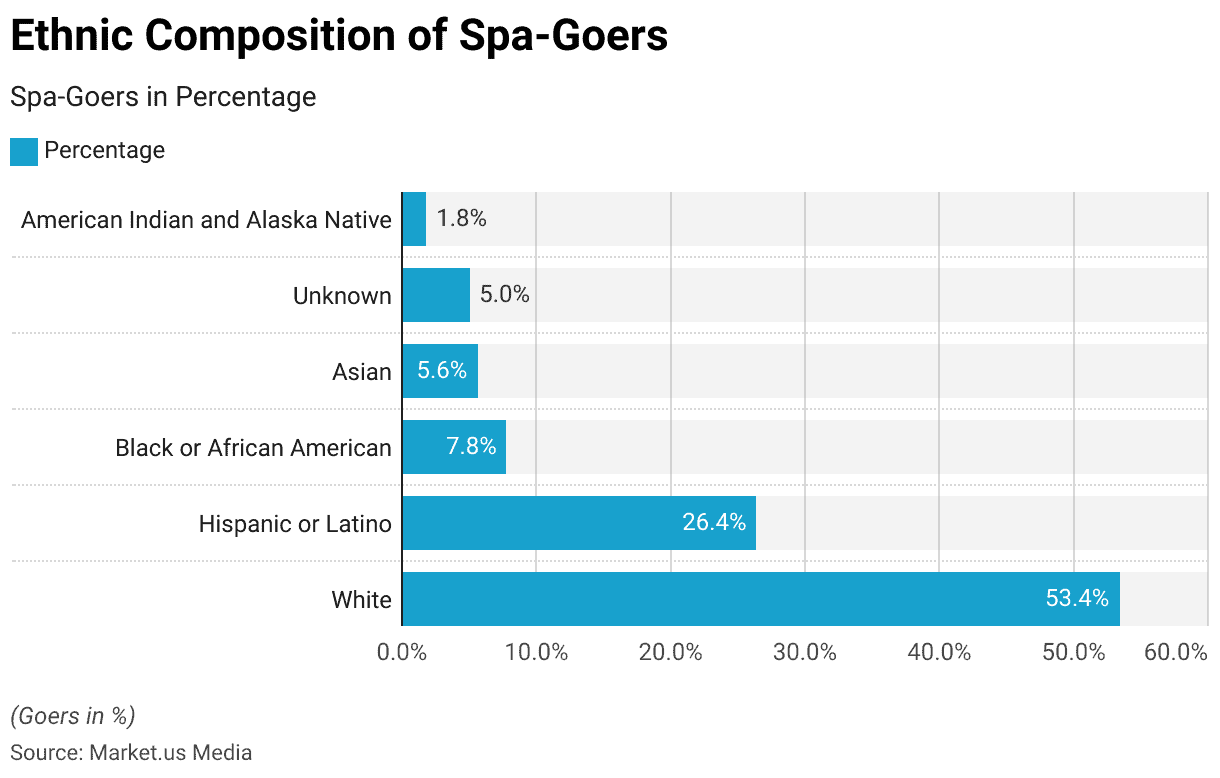Table of Contents
- Introduction
- Editor’s Choice
- Spa Industry Statistics – General
- Spa Industry Statistics – Spa Services and Treatments
- Demographics of Spa-Goers
- Spa Industry Statistics – Attendant Demographics by Race
- Economic Advantages of Resort Spas: Survey of Hotel Managers
- Financial Performance of Hotel Spa Operations: Demand Patterns and Trends
- Spa Industry Statistics – Establishments by Type
- Spa Industry Statistics – Staffing Trends
- Spa Industry Statistics – Spa Industry Profitability Soars
- Spa Industry in the United States
- Recent Developments
- Wrap Up
- FAQs
Introduction
Spa Industry Statistics: The spa industry has experienced significant growth and transformation over the years, driven by increasing consumer interest in health, wellness, and relaxation.
Spas offers a range of services and treatments aimed at rejuvenating the body, mind, and spirit. From traditional massage therapies to advanced skin care treatments, spas cater to diverse customer needs and preferences.

Editor’s Choice
- The Global Medical Spa Market size is expected to be worth around USD 59.4 Billion by 2033, from USD 17.2 Billion in 2023, growing at a CAGR of 13.2% during the forecast period from 2024 to 2033.
- The global market size of the spa industry was around $95 billion in 2021. By 2030, the global market size of the spa industry is expected to exceed $185 billion.
- The spa services market, including massage services, beauty and grooming, and physical fitness, is projected to reach over $133 billion by 2027.
- The United States spa industry generated approximately $20.8 billion in revenue in 2022.
- Massage therapy is one of the most popular spa services, accounting for approximately 70% of spa visits in the United States.
- The average spa-goer in the United States spends $87 per visit and visits spas 2.3 times per year.
- The spa industry employs over 2.5 million people globally.
- The wellness tourism market, which includes spa travel, was valued at $735 billion in 2021.
(Source: Statista, International Spa Association, Global Wellness Institute)

Spa Industry Statistics – General
- Total spa industry revenue experienced a significant increase of 49.4%, rising from $12.1 billion in 2020 to $18.1 billion in 2021, marking a growth of $6 billion.
- The number of spa visits in 2021 reached an estimated 173 million, showing a substantial increase of 39.5% compared to the 124 million visits in 2020.
- The number of spa locations remained relatively stable, with a marginal decline of -0.2% in 2021, reaching a total of 21,510, after a 4% drop in 2020.
- The average revenue per spa visit witnessed a sharp increase of 7.1%, rising from $97.50 in 2020 to $104.50 in 2021.
- Employment in the spa industry showed positive growth, with an estimated overall increase of 13.2%. Full-time employment expanded by 15.8%, slightly outpacing part-time employment, which grew by 12.1%. However, contract employment experienced a slight decline of -0.7%.
(Source: experiences)
| 2020 (Year End) | 2021(Year End) | % Change | |
| Revenue | $12.1 billion | $18.1 billion | 49.4% |
| Spa Visits | 124 million | 173 million | 39.5% |
| Locations | 21,560 | 21,510 | -0.2% |
| Revenue per visit | $97.50 | $104.50 | 7.1% |
Spa Industry Statistics – Spa Services and Treatments
- Massage therapy is the most popular spa treatment, accounting for approximately 70% of spa visits in the United States.
- Facial treatments are also highly popular, with approximately 55% of spa-goers choosing these services.
- Body treatments, such as wraps and scrubs, are preferred by around 37% of spa visitors.
- Aromatherapy is a widely offered service, with more than 80% of spas incorporating it into their treatments.
- Reflexology, a foot massage technique, is gaining popularity with around 20% of spas offering this service.
- The wellness and holistic services segment is expanding, with services like yoga, meditation, and mindfulness being offered in over 70% of spas.
- Alternative therapies such as acupuncture, Reiki, and energy healing, are available in approximately 25% of spas.
- CBD-infused treatments, incorporating products with cannabidiol, have gained popularity, with around 13% of spas offering these services.
(Source: Global Wellness Institute)
Demographics of Spa-Goers
- In the United States, the largest age group of spa-goers is between 35 and 54 years old, accounting for 48% of spa visits.
- Millennials are increasingly becoming spa-goers, representing 38% of all spa visits in the United States.
- Women tend to make up the majority of spa-goers, approximately 85% of spa visits in the United States.
- In the United States, 33% of spa-goers have an annual household income of $100,000.
- Spa-goers in the United States spend an average of $87 per visit, including both services and products.
- In a survey conducted by the Global Wellness Institute, 34% of global wellness tourists reported spending over $500 per day on wellness-related activities, including spa treatments.
- Recommendations from family and friends play a significant role in spa selection, with 63% of spa-goers in the United States citing referral as an influential factor.
- Online reviews and ratings also impact consumer choices, with 39% of spa-goers in the United States considering them when selecting a spa.
- 62.8% of spa attendants are women and 37.2% of spa attendants are men.
(Source: International Spa Association, Zippia)

Spa Industry Statistics – Attendant Demographics by Race
- The largest ethnic group among spa-goers in the United States is White, accounting for 53.4% of spa visits.
- Hispanic or Latino individuals make up 26.4% of spa visits in the United States.
- Black or African American individuals represent 7.8% of spa visits in the United States.
- Asian individuals account for 5.6% of spa visits in the United States.
- The ethnic background of spa-goers is classified as Unknown in 5.0% of cases.
- American Indian and Alaska Native individuals make up 1.8% of spa visits in the United States.

Economic Advantages of Resort Spas: Survey of Hotel Managers
- According to the survey conducted by Health Fitness Dynamics, an overwhelming 97% of resort/hotel managers believed that having a spa was a marketing advantage.
- 83% of the managers reported that the presence of a spa on their property led to increased revenues per occupied room.
- A substantial 73% of the respondents agreed that having a spa in their establishment increased occupancy rates.
- Approximately 43% of hotel managers believed that a spa positively influenced guests’ length of stay, encouraging them to spend more time at the resort.
- 57% of the surveyed managers indicated that the presence of a spa enabled them to charge higher room rates.
- A significant majority, 70% of the respondents, stated that a spa enhanced the perceived value of the room rate charged.
- In another survey by Spa-per, over 80% of respondents expressed a preference for resorts with a spa, indicating that the presence of a spa influenced their choice of accommodation over others.
- 27% of managers reported that having a spa led to an increase in the number of people per occupied room.
(Source: digital commons)
Take advantage of our unbeatable offer - buy now!

Financial Performance of Hotel Spa Operations: Demand Patterns and Trends
A study conducted by Foster and Mandelbaum analyzed 88 properties and revealed the following statistics on spa revenues:
- Spa revenues averaged $2,076 per available room, accounting for 2.3% of total revenue.
- Resort spas contributed significantly more than urban hotel spas due to differences in the length of stay.
- Hotel spas generating over $1 million in revenue contributed an average of 5.3% of the total revenue for their properties.
- Spas generating less than $500,000 in revenue represented less than half of the total revenue at their respective hotels.
Spa Industry Statistics – Establishments by Type
Day Spas
- Day spas accounted for the majority, 78.3%, of the total 21,510 establishments in the spa industry.
- By the end of 2021, approximately 16,900 day spa establishments were operating in the U.S.
- This number showed a slight decrease from the 2020 estimate of 16,920 day spa establishments.
Resort/Hotel Spas
- Resort/hotel spas represented 9.7% of the total number of spa establishments.
- The number of resort/hotel spas increased by 2.9% from 2,030 in 2020 to an estimated 2,090 in 2021.
Medical Spas
- Medical spas accounted for 8.3% of the total spa establishments.
- The number of medical spas declined by -2.2% compared to 2020, estimated at 1,790 in 2021.
Club Spas
- Club spas represented a smaller segment of the industry.
- In 2020, there were an estimated 650 club spa locations, indicating a 3.6% increase compared to the previous year.
(Source: experienceispa)
Spa Industry Statistics – Staffing Trends
2021
- 63% of survey respondents reported an increase in their staff count compared to January 2021.
- Among the spa businesses that increased their staff, 37% experienced a staff increase of less than 10%, while 26% had a staff increase of 10% or more.
- Day spa businesses had a higher likelihood of increasing their staff count compared to resort/hotel businesses, with 62% and 48% reporting an increase, respectively.
- Among resort/hotel businesses, 36% reported having fewer staff employed compared to January 2021. In contrast, only 22% of day spa businesses reported a decrease in staff.
- 52% of spas operating at reduced hours increased their staffing, while 70% of spas operating all their desired hours reported an increase in staff count.
(Source: experienceispa)
2022
- Total employment in the spa industry reached 345,000 in January 2022, reflecting a 13% increase (+40,200) compared to January 2021.
- The spa workforce in January 2022 was at 90% of the pre-pandemic level in January 2020 (383,700).
- Full-time employees experienced a significant rise of 15.8%, reaching 162,800 in January 2022.
- Part-time employment also increased, with a growth of 12.1%, reaching 167,100 in January 2022.
- Employment of independent contractors remained relatively stable, with a minor decrease of less than 1%.
- The industry-wide average number of employees per spa location increased from 14.1 in January 2021 to 16 in January 2022, which was 6% below the pre-pandemic average of 17.1 in January 2020.
(Source: experienceispa)
Spa Industry Statistics – Spa Industry Profitability Soars
Resort/Hotel Spa Profitability
- The proportion reporting a loss dropped significantly from 31% in 2020 to 2% in 2021.
- In 2021, 71% of resort/hotel spas reported a spa profit percentage of 20% or more, a substantial increase from 24% in 2020.
- This percentage was slightly higher than the pre-pandemic level of 61% in 2019.
- Detailed profit percentage results showed that 26% of resort/hotel spas reported a spa profit percentage of 35% or more, while 45% cited a profit percentage in the range of 20% to 35%.
Non-Resort/Hotel Spa Profitability
- The proportion reporting a loss decreased from 28% in 2020 to 7% in 2021, aligning with the historical average.
- Excluding the resort/hotel sector, 72% of spas reported a profit percentage of 10% or more, a significant increase from 45% in 2020.
- The most frequently cited profit percentage range was 10%-15%, reported by almost one in four spas (24%).
- Approximately 21% of spas reported a profit percentage of 35% or more.
(Source: experienceispa)
Spa Industry in the United States
- The spa industry in the U.S. consisted of approximately 16,900 day spa establishments by the end of 2021.
- Day spas accounted for the majority, representing 78.3% of the total 21,510 spa establishments in the country.
- Total employment in the U.S. spa industry reached 345,000 in January 2022, reflecting a 13% increase (+40,200) compared to January 2021.
- The spa workforce in January 2022 was at 90% of the pre-pandemic level in January 2020 (383,700).
- In 2021, the proportion of resort/hotel spas in the U.S. reporting a loss dropped from 31% in 2020 to 2%.
- Across the rest of the spa industry, the proportion reporting a loss fell from 28% in 2020 to 7%, approximately in line with the historical average.
- In 2022, the estimated value of the spa industry in the United States was approximately $20.1 billion.
- In 2021, the U.S. spa industry was valued at just over $18 billion.
(Source: International Spa Association – ISPA, Statista)

Recent Developments
Merger and Acquisition Activity:
- In the past year, the spa industry has seen a surge in merger and acquisition activity, with several major spa chains acquiring smaller spas to expand their market presence.
New Spa Openings and Expansions:
- Despite challenges posed by the COVID-19 pandemic, the spa industry has witnessed resilience, with new spa openings globally in the last quarter.
- This signifies continued investment and growth in the sector, driven by consumer demand for wellness services.
Innovative Service Offerings:
- Spas has introduced innovative service offerings to meet evolving consumer preferences, including holistic wellness treatments, personalized wellness programs, and technology-driven experiences.
Investment in Wellness Technology:
- The spa industry has embraced wellness technology, with significant investments in digital booking platforms, mobile apps, and virtual wellness consultations.
- Total investment in wellness technology startups reached higher in the past year, supporting digital transformation efforts across the industry.
Focus on Sustainability:
- Sustainability has become a key focus for spas, with a growing emphasis on eco-friendly practices and green initiatives.
- Spas are adopting measures such as energy-efficient lighting, eco-friendly product lines, and waste reduction strategies, leading to a decrease in carbon footprint.
Partnerships and Collaborations:
- Spas is forming strategic partnerships with wellness brands, hotels, and travel agencies to offer integrated wellness experiences.
- Collaborations with health and fitness providers have resulted in combined packages that include spa treatments, fitness classes, and nutritional guidance. These partnerships have contributed to an increase in bookings for integrated wellness packages.
Wrap Up
The spa industry has witnessed significant growth and transformation, driven by the increasing demand for health, wellness, and relaxation services.
The global spa market is projected to surpass $185 billion by 2030, with the United States generating approximately $20.8 billion in revenue in 2022 alone.
Resort/hotel spas have experienced improved profitability, significantly decreasing reported losses. The spa industry attracts a diverse customer base, including millennials and higher-income individuals. Overall, the spa industry plays a vital role in promoting wellness and relaxation, and its prospects appear promising.
FAQs
A spa is a facility that offers various wellness and relaxation treatments, such as massages, facials, body treatments, and hydrotherapy. It provides a serene environment for individuals to unwind and rejuvenate their body, mind, and spirit.
Spas offers a wide range of services, including massages, facials, body wraps, manicures and pedicures, hair treatments, aromatherapy, saunas, steam rooms, and relaxation lounges. Some spas may also provide specialized treatments like acupuncture, reflexology, and energy healing.
The global spa industry was estimated to be around $95 billion in 2021 and is projected to exceed $185 billion by 2030.
In 2022, the spa industry in the United States generated approximately $20.8 billion in revenue.
Massage therapy is the most popular spa service, accounting for approximately 70% of spa visits in the United States. Other popular services include facial treatments, body treatments, aromatherapy, and holistic wellness services like yoga and meditation.
Discuss your needs with our analyst
Please share your requirements with more details so our analyst can check if they can solve your problem(s)



